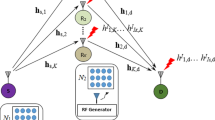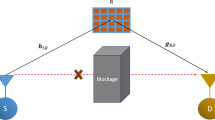Abstract
We consider an energy-efficient reconfigurable intelligent surface (RIS)-aided decode-and-forward relay cooperation scheme with minimum-rate guarantee. Although the emerging RIS has a similar role as the traditional relay, RIS and relay are essentially different and can complement each other. Firstly, we derive the upper bounds on the energy efficiency (EE) of the considered scheme over Rayleigh fading channels for given transmit powers at the source and relay. Secondly, we investigate the EE optimization problem with minimum-rate guarantee in two scenarios with fixed and upper-bounded total transmit powers. In the fixed power scenario, the phase shifts at two time slots are optimized based on the channel state information (CSI), and then the EE optimization problem is reformulated to an equivalent optimal power allocation problem with minimum-rate guarantee, which can be solved by convex optimization techniques. In the upper-bounded power scenario, the corresponding non-convex EE optimization problem is solved by the proposed method using fractional programming and generalized Dinkelbach’s algorithm. Finally, illustrative simulation results demonstrate the superiorities of the considered scheme as compared with the benchmark schemes and reveal the effects of various factors on its performance. Simulation results also show the good robustness of the considered scheme against imperfect CSI and discrete phase shifts of RIS.














Similar content being viewed by others

Data availibility
All data generated or analysed during this study are included in this article.
References
Su, Y., Lu, X., Zhao, Y., et al. (2019). Cooperative communications with relay selection based on deep reinforcement learning in wireless sensor networks. IEEE Sensors Journal, 19(20), 9561–9569. https://doi.org/10.1109/JSEN.2019.2925719
Zhang, Z., Jin, S., Chen, H., et al. (2008). A cooperation strategy based on Nash bargaining solution in cooperative relay networks. IEEE Transactions on Vehicular Technology, 57(4), 2570–2577. https://doi.org/10.1109/TVT.2007.912960
Laneman, J. N., Wornell, G. W., & Tse, D. N. C. (2001). An efficient protocol for realizing cooperative diversity in wireless networks. In Proceedings of IEEE international symposium on information theory, Washing (pp. 294–297). https://doi.org/10.10.1109/ISIT.2001.936157
Yao, S., Kim, T. T., Skoglund, M., et al. (2013). Half-duplex relaying over slow fading channels based on quantize-and-forward. IEEE Transactions on Information Theory, 59(2), 860–872. https://doi.org/10.1109/TIT.2012.2224318
Zhang, S., Yang, F., & Tang, L. (2015). Network-coding-based multisource multirelay LDPC-coded cooperative MIMO. Transactions on Emerging Telecommunications Technologies, 16(3), 491–502. https://doi.org/10.1002/ett.2659
Jin, X. L., & Kim, H. N. (2018). A new switching superposition strategy in decode-forward relay system. IEEE Transactions on Vehicular Technology, 67(8), 7826–7830. https://doi.org/10.1109/TVT.2018.2835837
Tataria, H., Shafi, M., Molisch, A. F., et al. (2021). 6G Wireless systems: Vision, requirements, challenges, insights, and opportunities. Proceedings of the IEEE, 109(7), 1166–1199. https://doi.org/10.1109/JPROC.2021.3061701
You, X. H., Wang, C. X., Huang, J., et al. (2021). Towards 6G wireless communication networks: Vision, enabling technologies, and new paradigm shifts. Science China Information Sciences, 64(1), 1–74. https://doi.org/10.1007/s11432-020-2955-6
Renzo, M. D., Zappone, A., Debbah, M., et al. (2020). Smart radio environments empowered by reconfigurable intelligent surfaces: How it works, state of research, and road ahead. IEEE Journal on Selected Areas in Communications, 38(11), 2450–2525. https://doi.org/10.1109/JSAC.2020.3007211
Tang, W. K., Chen, M. Z., Dai, J. Y., et al. (2020). Wireless communications with programmable metasurface: New paradigms, opportunities, and challenges on transceiver design. IEEE Wireless Communication, 27(2), 180–187. https://doi.org/10.1109/MWC.001.1900308
Renzo, M. D., Debbah, M., Phan-Huy, D., et al. (2019). Smart radio environments empowered by reconfigurable AI meta-surfaces: An idea whose time has come. EURASIP Journal on Wireless Communications and Networking. https://doi.org/10.1186/s13638-019-1438-9
Alexandropoulos, G. C., Lerosey, G., Debbah, M., et al. (2020). Reconfigurable intelligent surfaces and metamaterials: The potential of wave propagation control for 6G wireless communications. arXiv:2006.11136
Jian, M., Alexandropoulos, G. C., Basar, E., et al. (2022). Reconfigurable intelligent surfaces for wireless communications: Overview of hardware designs, channel models, and estimation techniques. Intelligent and Converged Networks, 3(1), 1–32. https://doi.org/10.23919/ICN.2022.0005
Alexandropoulos, G. C., Stylianopoulos, K., Huang, C., et al. (2022). Pervasive machine learning for smart radio environments enabled by reconfigurable intelligent surfaces. Proceedings of the IEEE, 110(9), 1494–1525. https://doi.org/10.1109/JPROC.2022.3174030
Strinati, E. C., Alexandropoulos, G. C., Wymeersch, H., et al. (2021). Reconfigurable, intelligent, and sustainable wireless environments for 6G smart connectivity. IEEE Communications Magazine, 59(10), 99–105. https://doi.org/10.1109/MCOM.001.2100070
Elmossallamy, M. A., Zhang, H., Song, L., et al. (2020). Reconfigurable intelligent surfaces for wireless communications: Principles, challenges, and opportunities. IEEE Transactions on Cognitive Communications and Networking, 6(3), 990–1002. https://doi.org/10.1109/TCCN.2020.2992604
Tang, W. K., Dai, J. Y., Chen, M. Z., et al. (2020). MIMO transmission through reconfigurable intelligent surface: System design, analysis, and implementation. IEEE Journal on Selected Areas in Communications, 38(11), 2683–2699. https://doi.org/10.1109/JSAC.2020.3007055
Ye, J., Guo, S., & Alouini, M. S. (2020). Joint reflecting and precoding designs for SER minimization in reconfigurable intelligent surfaces assisted MIMO systems. IEEE Transactions on Wireless Communications, 19(8), 5561–5574. https://doi.org/10.1109/TWC.2020.2994455
Li, S., Duo, B., Yuan, X., et al. (2020). Reconfigurable intelligent surface assisted UAV communication: Joint trajectory design and passive beamforming. IEEE Wireless Communications Letters, 9(5), 716–720. https://doi.org/10.1109/LWC.2020.2966705
Ranjha, A., & Kaddoum, G. (2021). URLLC facilitated by mobile UAV relay and RIS: A joint design of passive beamforming, blocklength and UAV positioning. IEEE Internet of Things Journal, 8(6), 4618–4627. https://doi.org/10.1109/JIOT.2020.3027149
Wu, Q., & Zhang, R. (2020). Joint active and passive beamforming optimization for intelligent reflecting surface assisted SWIPT under QoS constraints. IEEE Journal on Selected Areas in Communications, 38(8), 1735–1748. https://doi.org/10.1109/JSAC.2020.3000807
Pan, C., Ren, H., Wang, K., et al. (2020). Intelligent reflecting surface aided MIMO broadcasting for simultaneous wireless information and power transfer. IEEE Journal on Selected Areas in Communications, 38(8), 1719–1734. https://doi.org/10.1109/JSAC.2020.3000802
Wang, H., Liu, C., Shi, Z., et al. (2020). On power minimization for IRS-aided downlink NOMA systems. IEEE Wireless Communications Letters, 9(11), 1808–1811. https://doi.org/10.1109/LWC.2020.2999097
Hou, T., Liu, Y., Song, Z., et al. (2020). MIMO-NOMA networks relying on reconfigurable intelligent surface: A signal cancellation based design. IEEE Transactions on Communications, 68(11), 6932–6944. https://doi.org/10.1109/TCOMM.2020.3018179
Di Renzo, M., Ntontin, K., Song, J., et al. (2020). Reconfigurable intelligent surfaces vs relaying: Differences, similarities, and performance comparison. The IEEE Open Journal of the Communications Society, 2020(1), 798–807. https://doi.org/10.1109/OJCOMS.2020.3002955
Björnson, E., Özdogan, Ö., & Larsson, E. G. (2020). Intelligent reflecting surface versus decode-and-forward: How large surfaces are needed to beat relaying? IEEE Wireless Communications Letters, 9(2), 244–248. https://doi.org/10.1109/LWC.2019.2950624
Yildirim, I., Kilinc, F., Basar, E., et al. (2021). Hybrid RIS-empowered reflection and decode-and-forward relaying for coverage extension. IEEE Communications Letters, 25(5), 1692–1696. https://doi.org/10.1109/LCOMM.2021.3054819
Abdullah, Z., Chen, G., Lambotharan, S., et al. (2020). A hybrid relay and intelligent reflecting surface network and its ergodic performance analysis. IEEE Wireless Communications Letters, 9(10), 1653–1657. https://doi.org/10.1109/LWC.2020.2999918
Ying, X., Demirhan, U., & Alkhateeb, A. (2020). Relay aided intelligent reconfigurable surfaces: Achieving the potential without so many antennas. arXiv:2006.06644v1
Abdullah, Z., Chen, G., Lambotharan, S., et al. (2021). Optimization of intelligent reflecting surface assisted full-duplex relay networks. IEEE Wireless Communications Letters, 10(2), 363–367. https://doi.org/10.1109/LWC.2020.3031343
Gandotra, P., Jha, R. K., & Jain, S. (2017). Green communication in next generation cellular networks: A survey. IEEE Access, 5, 11727–11758. https://doi.org/10.1109/ACCESS.2017.2711784
Ma, J., Huang, C., Cui, S., et al. (2019). Energy efficiency of amplify-and-forward full-duplex relay channels. IEEE Wireless Communications Letters, 8(5), 1365–1368. https://doi.org/10.1109/LWC.2019.2918290
Zhou, X., & Li, Q. (2018). Energy efficiency for SWIPT in MIMO two-way amplify-and-forward relay networks. IEEE Transactions on Vehicular Technology, 67(6), 4910–4924. https://doi.org/10.1109/TVT.2018.2819682
Ntontin, K., Renzo, M. D., & Lazarakis, F. (2020). On the rate and energy efficiency comparison of reconfigurable intelligent surfaces with relays. SPAWC. https://doi.org/10.1109/SPAWC48557.2020.9154308
Li, Y., Xiong, J., Kwan Ng, D. W., et al. (2021). Energy efficiency and spectral efficiency tradeoff in RIS-aided multiuser MIMO uplink transmission. IEEE Transactions on Signal Processing, 69, 1407–1421. https://doi.org/10.1109/TSP.2020.3047474
Su, Y., Pang, X., Chen, S., et al. (2022). Spectrum and energy efficiency optimization in IRS-assisted UAV networks. IEEE Transactions on Communications, 70(10), 6489–6502. https://doi.org/10.1109/TCOMM.2022.3201122
Zhuang, Y., Li, X., Ji, H., et al. (2022). Exploiting intelligent reflecting surface for energy efficiency in ambient backscatter communication-enabled NOMA networks. IEEE Transactions on Green Communications and Networks, 6(1), 4157–4170. https://doi.org/10.1109/TGCN.2022.3144465
Abdullah, Z., Alexandropoulos, G. C., Kisseleff, S., et al. (2022). Combining relaying and reflective surfaces: Power consumption and energy efficiency analysis. arXiv:2210.05589
Basar, E., Di Renzo, M., De Rosny, J., et al. (2019). Wireless communications through reconfigurable intelligent surfaces. IEEE Access, 7, 116753–116773. https://doi.org/10.1109/ACCESS.2019.2935192
Dinkelbach, W. (1967). On nonlinear fractional programming. Management Science, 13(7), 492–498. https://doi.org/10.1287/mnsc.13.7.492
Zappone, A., & Jorswieck, E. (2015). Energy efficiency in wireless networks via fractional programming theory. Foundations and Trends in Communications and Information Theory, 11(3–4), 185–399. https://doi.org/10.1561/0100000088
Huang, C., Zappone, A., Alexandropoulos, G. C., et al. (2019). Reconfigurable intelligent surfaces for energy efficiency in wireless communication. IEEE Transactions on Wireless Communications, 18(8), 4157–4170. https://doi.org/10.1109/TWC.2019.2922609
Alexandropoulos, G. C., Papadogiannis, A., & Berberidis, K. (2010). Performance analysis of cooperative networks with relay selection over Nakagami-m fading channels. IEEE Signal Processing Letters, 17(5), 441–444. https://doi.org/10.1109/LSP.2010.2042992
Zhang, J., Zhang, T., Huang, J., et al. (2009). Symbol error rate of selective cooperation in Nakagami-m environments. ICIEA. https://doi.org/10.1109/ICIEA.2009.5138307
Funding
This work was supported in part by the National Natural Science Foundation of China under Grant 61501256, in part by the Natural Science Foundation of Jiangsu Higher Education Institutions under Grant 20KJB510034, in part by the open research fund of Key Lab of Broadband Wireless Communication and Sensor Network Technology (Nanjing University of Posts and Telecommunications), Ministry of Education under Grant JZNY202112, and in part by the NUPTSF under Grant NY219073.
Author information
Authors and Affiliations
Contributions
All authors contributed to the study conception and design, and all authors commented on previous versions of the manuscript. All authors read and approved the final manuscript.
Corresponding author
Ethics declarations
Conflict of interest
The corresponding author states that there is no conflict of interest.
Additional information
Publisher's Note
Springer Nature remains neutral with regard to jurisdictional claims in published maps and institutional affiliations.
Appendices
Appendix A
Lemma 1
For any \({\tilde{\textbf{P}}} \in S\) and \({\xi _{\tilde{\textbf{P}}}} = \mathop {\min }\limits _{1 \le k \le K} \frac{{{f_k}\left( {\tilde{\textbf{P}}} \right) }}{{{g_k}\left( {\tilde{\textbf{P}}} \right) }}\), we have \(F\left( {{\xi _{\tilde{\textbf{P}}}}} \right) \ge 0\), with equality if and only if \({\tilde{\textbf{P}}} = \arg \mathop {\max }\limits _{{\textbf{P}} \in S} \left\{ \mathop {\min }\limits _{1 \le k \le K} \left\{ {{f_k}\left( {\textbf{P}} \right) - {\xi _{\tilde{\textbf{P}}}}{g_k}\left( {\textbf{P}} \right) } \right\} \right\} \).
Proof
For any \({\tilde{\textbf{P}}} \in S\) and \({\xi _{\tilde{\textbf{P}}}} = \mathop {\min }\limits _{1 \le k \le K} \frac{{{f_k}\left( {\tilde{\textbf{P}}} \right) }}{{{g_k}\left( {\tilde{\textbf{P}}} \right) }}\), Lemma 1 can be obtained as follows:
(a: The equation holds if and only if \({\tilde{\textbf{P}}} = \arg \mathop {\max }\limits _{{\textbf{P}} \in S}\bigg \{ \mathop {\min }\limits _{1 \le k \le K} \left\{ {{f_k}\left( {\textbf{P}} \right) - {\xi _{\tilde{\textbf{P}}}}{g_k}\left( {\textbf{P}} \right) } \right\} \bigg \}\).) \(\square \)
Appendix B
Lemma 2
\(F\left( \xi \right) \) is strictly monotonic decreasing and has a unique root.
Proof
Supposing that \({\xi _2} > {\xi _1}\), and \({\textbf{P}}_2^* = \arg \mathop {\max }\limits _{{\textbf{P}} \in S} \left\{ \mathop {\min }\limits _{1 \le k \le K} \left\{ {{f_k}\left( {\textbf{P}} \right) - {\xi _2}{g_k}\left( {\textbf{P}} \right) } \right\} \right\} \), then we can obtain the assertion that \(F\left( \xi \right) \) is strictly monotonic decreasing as follows:
Besides, it can be seen that \(\mathop {\lim }\limits _{\xi \rightarrow - \infty } F\left( \xi \right) = + \infty \), and \(\mathop {\lim }\limits _{\xi \rightarrow + \infty } F\left( \xi \right) = - \infty \), thus \(F\left( \xi \right) \) has a unique root. \(\square \)
Rights and permissions
Springer Nature or its licensor (e.g. a society or other partner) holds exclusive rights to this article under a publishing agreement with the author(s) or other rightsholder(s); author self-archiving of the accepted manuscript version of this article is solely governed by the terms of such publishing agreement and applicable law.
About this article
Cite this article
Zhang, S., Song, L., Li, J. et al. Energy efficiency analysis and optimization for reconfigurable intelligent surface aided DF relay cooperation with minimum-rate guarantee. Telecommun Syst 83, 365–380 (2023). https://doi.org/10.1007/s11235-023-01024-2
Accepted:
Published:
Issue Date:
DOI: https://doi.org/10.1007/s11235-023-01024-2



